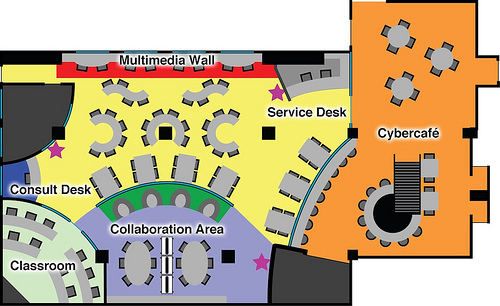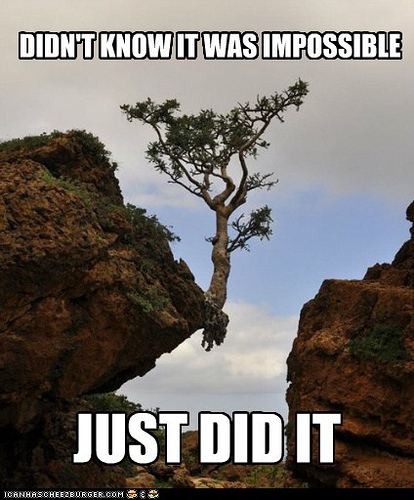Beginning with the end in mind | thinking about the learning | #K4STEMLAB

learningspaces (16)-uchicago by†smaedli†on Flickr (for illustrative purposes only - not a proposed design for my space)
"Start with learning first. †Space comes out of that." - David Jakes
David's quote came to me a couple of weeks ago in an email conversation with several others in my personal learning network about this little classroom initiative of mine. I've been thinking about his words ever since. My goal with this post is to describe the learning I envision taking place in the K4STEMLAB. So, here goes! Learning in my new classroom†will be:
- Self-directed & differentiated.†I have been telling people that the K4STEMLAB represents the end of students in my class "doing the same thing at the same time using the same software." My students will decide for themselves how to approach a challenge; how many times to review instructions (whatever form they take) and do so at their own pace; and to know they can skip the instructions entirely if they already know what to do.
- Grounded in experimentation. My students will learn for themselves by controlling as much as they can about the learning process. I want them to feel free to fail while learning.
- Collaborative. Students will work together, sometimes in assigned groups, sometimes with whom they choose, or whomever is nearby, to create & compose, review, question, reflect and ultimately complete a task†successfully.
- Multi-sensory. Some students prefer getting instructions from a person; some prefer using printed materials; some would rather watch a video. We will seek to accommodate them all.
- Science-focused. I want students to LOVE SCIENCE like the way they LOVE TECHNOLOGY in my classroom now. I want them to love asking questions about the world around them and I want them to wonder. I want them to take things apart, put things together, engineer things, and to tinker.
So what might this actually LOOK LIKE in a classroom? Try this on for size. It's an imaginary a 4th grade class. Some of what I describe below will have to be scaffolded for younger learners, and some won't be possible at all. But the K4STEMLAB is all about seeing how much of this we can make happen with essentially a ZERO BUDGET. Without further ado:

Students arrive with their teacher. Music can be heard in the background as they come in. They pick up their personal "daily challenge" folder, with in-progress projects or artifacts related to the task at hand. They grab a mobile device (probably a Chromebook) and log into our LMS (Learning Management System, probably Edmodo). They then interact with some other data gathering system (Google forms? Wikispace? Google Sites?) to update their status on project work, request information or assistance / collaboration with others. This information is posted in real time and acted on just as quickly.
At that point, they begin working on whatever it is they need to do, using whatever technology they need, a Chromebook, digital camera, a microscope, a magnifying glass, the SMART Board, etc. They tune into my video channel where they watch screencasts I have created for them illustrating the key tasks and possible ways to get it done. Some students use printed instructions I have prepared for them. Some are in a small group led by me or another teacher. The rest of the students group themselves on their own, moving around the room as needed. Some kids, having completed the assignment (possibly including parts at home), relax in the "Game Space," maybe by playing Cut the Rope or experimenting with Google Blocky†or TinkerCAD.†The majority of kids are busy working, spread around the room, sitting comfortably where they can find space. The kids almost completely manage themselves. They are enjoying a blended learning environment. [For more about blended learning, see:†Whatís Your Main Purpose For Blended Learning?†by Andrew Coulson and†The Flipped Classroom Model: A Full Picture by Jackie Gerstein.)]
As we approach the end of class, students update their status in the LMS with their progress for the day, upload anything they need to, perhaps print off an artifact, and put whatever they need into their "daily challenge" folder, which they put away. They line up and leave. When they get home from school, they can log into the LMS and continue working (because much of our instructional ecosystem will be web based), or even (yes, heaven forbid) work on their keyboarding skills via the online keyboarding program our district uses. When they reach pre-established keyboarding proficiency rates, they earn "badges," which display in the LMS. This applies to foundation skills like keyboarding as well as project work and even behavioral accomplishments (bestowed by me, like, for example, "Week's Best Invention"). They can even submit projects to me from home via the LMS, where I can assess, add comments and return them.
Tools and ideas to transform education. Sign up below.
Sound like a stretch? Yeah, it does to me too. (I'd be honored to be considered†one of the crazy ones.) But, here's the thing; that's why I'm so excited. I'm a sucker for a challenge!

This post is part of a series about our plans to "reinvent" my K-4 Computer Lab class as a STEM (Science, Engineering, Technology & Math) course starting in September 2012. By "thinking out loud" here I hope to keep stakeholders apprised of our ideas, activities & progress while I gain wisdom and perspective from anyone who cares to join the conversation.
